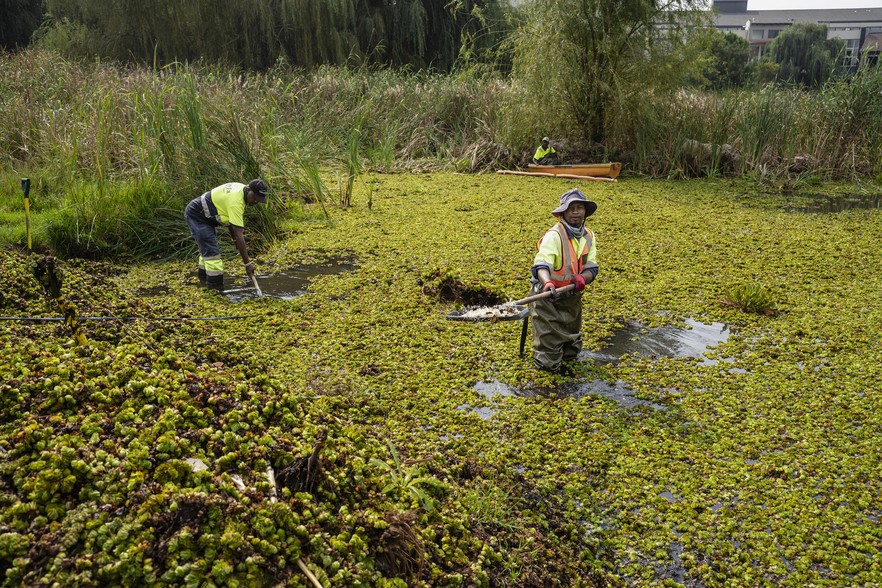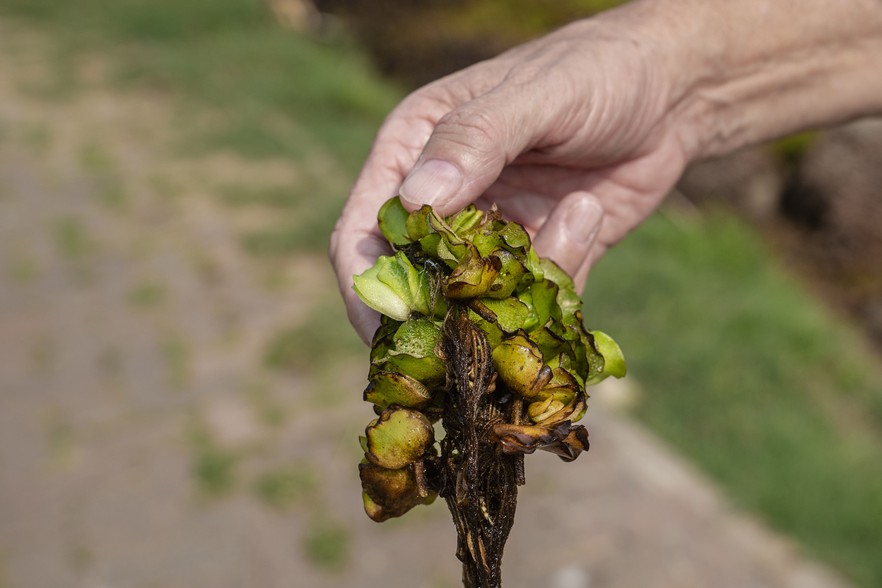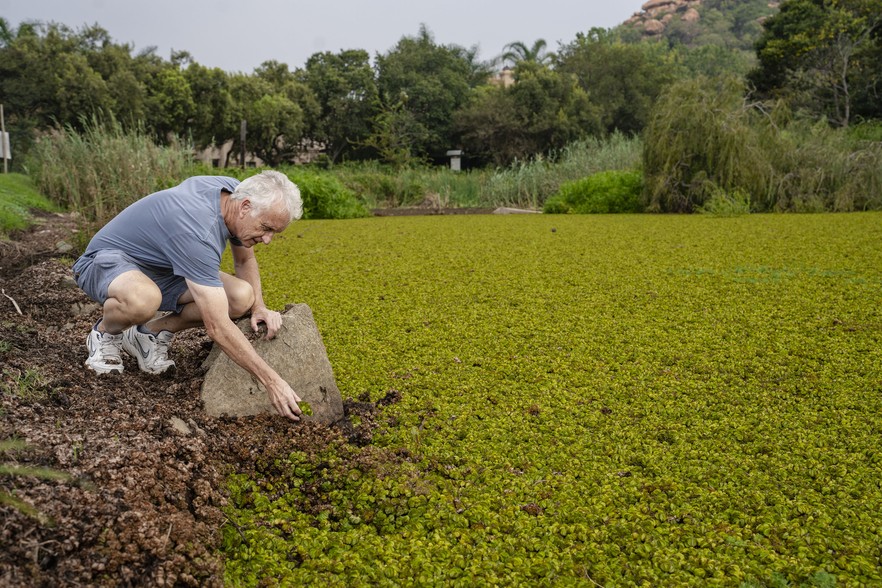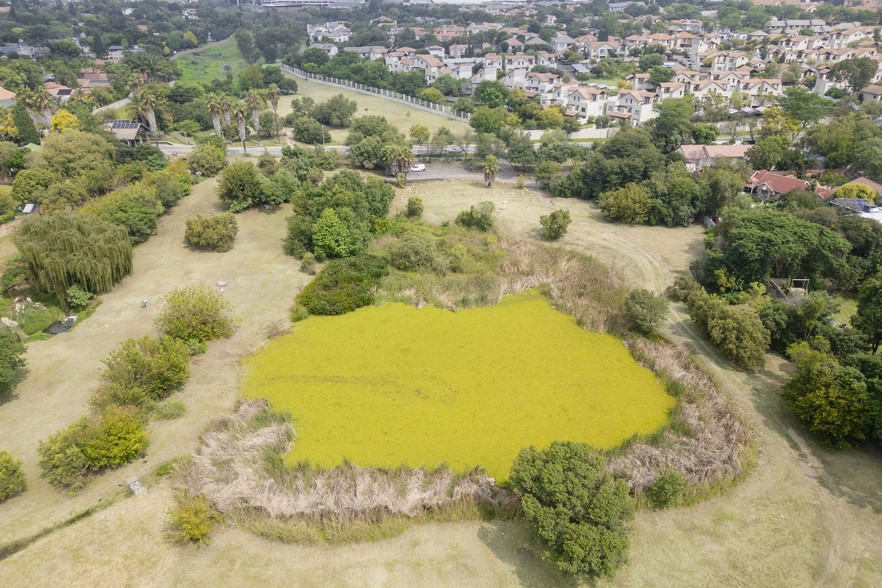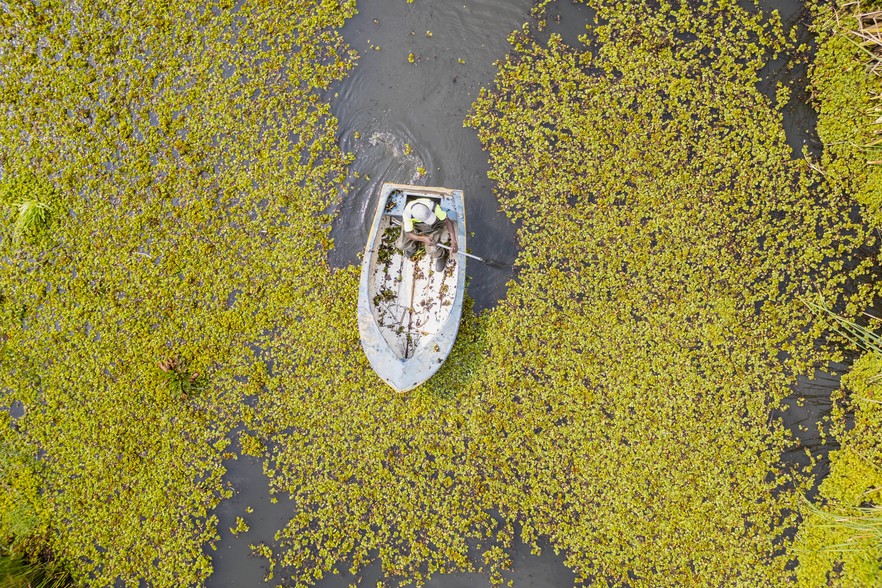Invasive weed is threatening life in Joburg dams
Kariba weed on the surfaces of the dams could kill the indigenous ecosystems
Workers from the Lonehill Community Improvement Initiative trying to remove invasive Kariba weed from the dam in Lonehill Park in Johannesburg. Photos: Ihsaan Haffejee
Once thriving with aquatic life, two dams in the north of Johannesburg are now completely blanketed by a thick, green invasive plant species.
The Salvinia Molesta, more commonly known as Kariba weed, is an invasive species of free-floating water fern from Brazil. The plant has spread over the surface of the dams in the Lonehill public park and nearby Witkoppen Spruit Park and is clogging up waterways.
The water fern settles on slow-moving or stagnant water, forming dense mats of up to 50cm thick, covering the surface of the water and blocking oxygen, threatening indigenous aquatic life.
Researchers have ranked the Kariba weed second only to water hyacinth on a list of the world’s most problematic aquatic weeds.
The thick vegetation also serves as breeding grounds for mosquitoes and bilharzia-carrying snails, according to signs put up by Johannesburg City Parks at the Lonehill dam.
Researchers have ranked the Kariba weed, second only to water hyacinth, on a list of the world’s most problematic aquatic weeds based on its impact on the environment and on livelihoods. Its impact on larger water bodies such as Lake Ossa in Cameroon, has been significant.
Invasive species are controlled by the National Environmental Management Biodiversity Act which divides species into four categories. The Kariba weed falls under Category 1b described as an “invasive species which must be controlled, and wherever possible, removed and destroyed. Any form of trade or planting is strictly prohibited”.
Local ward councillor David Foley says he is working with City of Johannesburg authorities to find a sustainable solution to the problem of the invasive species.
Ward councillor David Foley said residents noticed the rapid growth of the Kariba weed late last year. At first they tried to remove the plant themselves but the fern only grew back thicker and spread across the dam, says Foley.
He says they contacted Johannesburg City Parks officials, who allocated a portion of the budget to help remove the Kariba weed. “In January, around ten guys arrived with a small rowboat. They claimed they could remove everything in just a few hours. They ended up working for two weeks, trying to remove this stuff manually, but you couldn’t even see a difference because it grows back so thick and fast.”
Foley says that City Parks told them after two weeks the budget was used up.
Meanwhile Lonehill residents, through the Lonehill Community Improvement Initiative, have employed workers to clean the dam, but the weed is hard to eradicate.
An aerial view of the dam at the Witkoppen Spruit Park which shows it fully covered by the weed.
“We have to think of a sustainable solution otherwise the invasive species will just keep returning, because we have an issue of high nutrients in the water due to things like sewer leaks into our river systems,” said Daniel Masemola, director of Water Management and Biodiversity at the City of Johannesburg.
He suggested using a weed harvester and then introducing biological control in the form of water hyacinth planthopper, a tiny insect that feeds on the invasive species and eventually kills it.
A worker with the Lonehill Community Improvement Initiative rows his boat through the thick layer of weed.
The Kariba weed multiplies fast in nutrient-rich waters such as those polluted by wastewater.
Sewage has recently leaked into the dam at Lonehill after heavy rains.
Foley said that he is working with the relevant authorities at Joburg Water to ensure that sewage leaks are fixed promptly.
City responds
Gugu Zondi, Manager: Integrated Catchment Management at Johannesburg City Parks and Zoo, said the rapid growth of invasive species such as Salvinia molesta are often driven by water pollution, particularly from biological waste, with sewage leaks being a major contributor.
“The recent increase can be attributed to a combination of environmental and infrastructural factors. Cooler temperatures coupled with high rainfall have led to increased water levels in dams, which favour the spread of aquatic weeds,” said Zondi.
She confirmed that the environmental impact is substantial. “Dense mats of Salvinia molesta reduce oxygen levels in the water, smother aquatic life, and disrupt the natural balance of ecosystems.” Zondi said the City, through partnerships, aims to “address the root causes —particularly pollution from sewage leaks — while implementing mechanical removal and biological control methods.”
Support independent journalism
Donate using Payfast

Don't miss out on the latest news
We respect your privacy, and promise we won't spam you.
Next: Developer of R300m Stellenbosch housing estate fights back
Previous: Synagogue president apologises for calling for genocide
Letters
Dear Editor
I live in the area and quite frequently visit the Lonehill dam pictured in this article, and have noted with consternation that little proactive action has been taken to combat the Kariba weed comprehensively covering its surface and choking the water of oxygen. The response from the City Parks representative, Gugu Zondi, covered many of the big issues, making it plain that the weed itself is merely a symptom, rather than the source of the problem. Some key details are not apparent, however, such as who the partnerships she mentions are with, and whether they actually exist.
The root problem, as discussed in the original article, is that the dam is hypertrophic, which means it has an excessively high concentration of nutrients, typically nitrates and phosphate, and that drives the overgrowth of invasive plants. As long as that state is in place, completely eradicating an invasive plant once it has a foothold is next to impossible. In the case of Kariba Weed, it can regrow rapidly from even very small fragments, so the control methods mentioned, mechanical and biological, achieve only that – control, rather than elimination. Elimination would require that the sources of nutrients entering the dam be shut off, and also that the nutrients currently in it are depleted to the point that plant growth is suppressed. The article identified sewage leaks as a source of nutrients but, unfortunately, this is unlikely to be the only source; research has indicated that lawn irrigation runoff and road runoff, among others, are major sources of nutrient pollution in urban and suburban areas. The reality is that human habitation simply brings more nutrients into an area than would naturally be available, and entirely preventing their intrusion into waterways would require unrealistic lifestyle changes.
Consequently, the probability is that this a problem that has to be lived with rather than one that can be gotten rid of entirely, which means using control mechanisms, but allocating an adequate annual budget to apply them on an ongoing basis.
Biological control, a method using weevils that feed on parts of the Kariba weed plant, has been shown to be the cheaper method of keeping the surface clear, but with drawbacks – the damage caused by the weevils leads to the plant matter dying off and sinking to the bottom of the water, which returns their nutrient content to the water. It also leads to anaerobic decomposition of plant matter, which releases methane, a highly potent greenhouse gas which can also be hazardous under certain conditions, although it is highly improbable that enough of it could accumulate to pose a threat.
Using control mechanisms to keep the water surface clear has another drawback, however; a hypertrophic body of water with an uncovered surface, allowing in oxygen and sunlight, can be prone to blooms of algae or cyanobacteria. These are rapid overgrowths of algae or bacteria, some species of which produce toxins dangerous to humans and animals.
This means that aside from an ongoing programme to control the Kariba Weed, monitoring would also be necessary to raise the alarm if dangerous levels of toxins are detected. In the long run, more comprehensive solutions should be explored, such as establishment of a constructed wetland upstream of the dam to remove nutrients from the waterways before they arrive, and beneficiation of plant biomass to generate value in one way or another. Finding a good solution for this particular dam is perhaps not a pressing priority for the City or for the country, but finding general solutions should be – most of the waterways in South Africa’s populated areas will face similar problems eventually, if they are not already.
© 2025 GroundUp. This article is licensed under a Creative Commons Attribution-NoDerivatives 4.0 International License.
You may republish this article, so long as you credit the authors and GroundUp, and do not change the text. Please include a link back to the original article.
We put an invisible pixel in the article so that we can count traffic to republishers. All analytics tools are solely on our servers. We do not give our logs to any third party. Logs are deleted after two weeks. We do not use any IP address identifying information except to count regional traffic. We are solely interested in counting hits, not tracking users. If you republish, please do not delete the invisible pixel.

